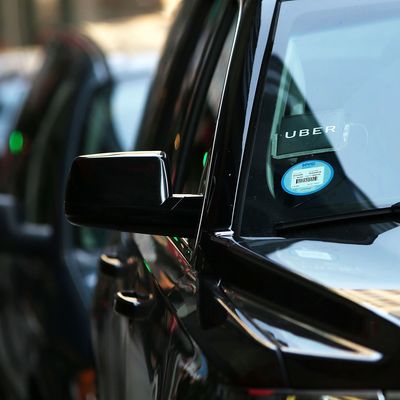
The speculation began as soon as Uber submitted its first IPO filing in late 2018: This could be the biggest initial public offering of the coming year, perhaps one of the largest of all time. Valued at up to $91 billion, the ride-sharing company’s IPO stands out in the “stampede of the unicorns” going public this year — Lyft and Pinterest last month, with Airbnb, Slack, WeWork, and Palantir among those expected later this year.
Uber would be the third-largest IPO on record. Only Alibaba and Facebook were more valuable. All of which makes some experts wonder what, exactly, all the outside expectations are built on. Is it overblown hype (the company lost as much as $1.1 billion in the first quarter of 2019; drivers in cities across the country will go on strike on May 8), or is Uber a good deal for investors? Here, 12 analysts, academics, journalists, and drivers themselves weigh in as the offering approaches.
Asad Hussain, emerging technology analyst at Pitchbook
The volatility in Lyft’s reception as well as reports around Uber’s latest pricing, which is around $90 to 100 billion, down from the $120 billion range we were hearing about late last year — we think this indicates investor hesitance. Both companies haven’t been tested during a downturn, and we think it’s going to be a real test for these companies, how they respond whenever the cycle rolls over. In terms of a platform play, all the things Uber is doing in terms of investments in international markets and autonomous vehicles over the long term … if things pan out for them, I could see them becoming — and this is how they’re positioning themselves — the Amazon of transportation. Commuters of the future might rely on them for ride sharing, but also last-mile urban trips using an electric bike or scooter, or to order food through their app. So a centralized platform that commuters and people might come to for all their needs.
I don’t know if they’re overselling the IPO, necessarily. It will be one of the largest IPOs in history, and will go a long way toward setting up 2019 as a record-breaking year for venture-capital exits.
Steven Hill, former director of the Political Reform Program at the New America Foundation and author of Raw Deal: How the Uber Economy and Runaway Capitalism Are Screwing American Workers
I think whatever level IPO Uber has, it’s going to tank like Lyft has. Because Uber is so much bigger than Lyft, in terms of all the companies that have invested in it, if that company tanks, I think it’ll be like the Enron of the transportation industry. In Silicon Valley, seven out of ten start-ups fail. I think that Uber is one of those seven out of ten. They haven’t figured out a profitable business model. They haven’t significantly raised fares because they’re afraid they’ll lose customers. If Uber raises its prices to the point where it can break even, I think a lot of their customer base will disappear.
Imagine waiting for driverless cars. How long will that take — 10, 20 years? Elon Musk is trying to hype things up because he’s had a difficult quarter. I just saw an interview with the head of Waymo, and he says this is years away. Sometimes companies promote technology that never comes to fruition. I think it’s possible driverless cars is one of those, that we’ll only see it in a very limited capacity — on a university campus, which is very contained, or an interstate, where all you have to do is go straight. But in major metropolitan areas, you may never have it.
Robbie Kellman Baxter, strategy consultant
What I’m really interested in with Uber is what is protectable, what competitive advantages do they have? I don’t mind companies losing money on acquisitions if they know retention is going to pay off in the long term. That’s the thing I have not seen. The data in their S-1 filing doesn’t really answer those questions for me.
I’m a big believer in business models that build protected relationships with customers so that customers don’t have alternatives. I don’t see loyalty emerging. You could say that the drivers are their members, or the riders are. It doesn’t seem like it’s optimized for either one, to prevent them from looking for alternatives.
Ryan Calo, University of Washington law professor
I think about the privacy-policy ramifications. I think about the effect on the driver of the architecture of Uber’s system. So from my perspective, the IPO could be a good thing. Because it broadens the stakeholders to stockholders more generally. It opens the company up to a wider range of stakeholders having some say over what the company does. So number one, while shareholders are hardly a proxy for the average resident or driver, there might be some folks among the investing community who try to hold Uber accountable. Second of all, obviously Uber has to disclose more about what it’s doing, what its risk factors are. There will be greater transparency, they’ll have to file with the SEC. I don’t think any of this stuff will be the panacea. There’s horrible behavior by publicly traded companies, going back decades. But those two levers are there that weren’t there before.
On the other side of it, there’s also the way that corporate law is structured: Uber will have a fiduciary responsibility to its stakeholders. That could mean that it creates an even greater incentive to maximize profits, coming at the expense of drivers and riders. So there’s always that push and pull.
Veena Dubal, associate professor of law at UC Hastings in San Francisco
How is it possible that a company that has no road to profitability, but also whose value creators are making below the living wage, can go public? Because transportation is so key for our economic realities, there are going to be ramifications not only for investors and workers but also for city planners. The IPO filings revealed a lot about the company. They revealed that there are probably no self-driving cars in our future, that the company doesn’t have a clear road to profitability. That should really give planners pause as they think about the privatization of public transit. It seems like an incredibly irresponsible and unethical move for this company to go public at this time.
I’m very skeptical of the potential this opens up for shareholder activism. What we’ve seen with other companies going public is real limitations of shareholders having impact on a business model. Shareholders at Google and Twitter have tried to put forward resolutions discouraging those companies from using arbitration agreements, or encouraging companies to better their diversity efforts. Those efforts have failed. To the extent that the company going public means more transparency, sure, that’s great. But the actual activist impact of shareholders — there’s no promising path for that.
Dan Ives, technology, internet, and media analyst, Wedbush
Look, Uber is a trillion-dollar ridesharing market opportunity over the next decade. Uber’s platform is really more of a distribution channel for some of their other money-makers like Eats and Freight. What makes them so potentially groundbreaking is that it’s a platform. More tech investors are looking for the Amazon-like platform models, which is why there’s been such focus on this IPO. Valuation is only in the eye of the beholder, but if you look at Uber’s positions, it’s a unique business model, company, and positioning. More investors in the street are trying to figure out who are the next Amazons? And Uber definitely is in that conversation, which is why there’s been so much excitement for their IPO.
For right or wrong, investors are focused on growth. Many investors over the last decade missed out on the Amazon run because they were so focused on profitability over growth. Many tech portfolio managers that missed Amazon are not currently employed because of that strategy. No one wants to miss out on the next Amazon. That fear is ultimately a positive for the likes of Uber.
Tom White, senior research analyst, DA Davidson
It’s important for folks to understand that in the days and weeks and arguably even months following a new listing like this, the movement of the stock has less to do with the fundamental value of the business than it does the supply-and-demand dynamics of these new issues. You’re seeing it with Lyft, and with Pinterest in the other direction. There tends to be a fair amount of volatility in the shares, which doesn’t reflect a change in the outlook or intrinsic value of the business, but whether somebody wants to own or sell the stock in these early days when the public market for shares is just being established. A large part of how the first few days will depend on where they price the deal.
Adam Lashinsky, author of Wild Ride: Inside Uber’s Quest for World Domination
If the issue is the real-estate market in San Francisco, it seems to me there’s no question the IPO will have a huge effect. You can do a guesstimate by looking at S-1s of Uber, Pinterest, Lyft, maybe Airbnb, and estimate how many employees are going to have a million dollars within six months of the IPO. My hunch is it’s a relatively large number, maybe tens of thousands of people.
Nicole Moore, driver organizer with Rideshare Drivers United
Drivers are already feeling the IPO. Lyft and Uber both have been squeezing wages from drivers in preparation. In March, in our market [Los Angeles], Uber cut the mileage rates from 80 cents to 60 cents, which is just 2 cents more than what the IRS reimburses people for workplace miles. It has deeply impacted the workforce. The companies have been doing those types of cuts, according to folks we’ve talked to in many markets across the country, in order to be more attractive to investors.
I know that the companies look like they’ve lost a lot of money — where’s the profit? Talking about that stuff in a market like L.A., in terms of Uber drivers, Uber is extremely profitable. We look at our mileage cards, our rate cards, at the breakdown of the fare. It used to be that drivers were guaranteed 80–85 percent of the fare. That’s not happening now. I saw some crazy fares from Coachella. Some passengers paying $40 and the driver received $6 or 7 from that ride. So there’s extremely high profit for the company there. It’s not a lot of expense to run the business — they do have the ability to share that with the workforce. Instead they’re choosing to open brand-new markets on the backs of drivers.
Robin Chase, co-founder of Zipcar and transportation entrepreneur
I’m really delighted by the extent to which this has pushed us to talk about the role of cars. Depending on whether you’re a pedestrian, cyclist, or driver of a personal car, you’re pissed off at Uber drivers double parking or drivers of delivery vans double parking. It’s causing people to say, what’s going on at the curb and who’s managing that? And there are these cyclist deaths. We should be reallocating our streets. Why are we letting 20 cars park on this block, which makes 20 people happy, rather than have a bike lane that will make hundreds happy? So, the status quo logic of how we allocate street space is being challenged. We’re finally having a congestion-pricing discussion — that’s great. I think the New York congestion-pricing plan will impact rideshares very positively for the city. Finally, everybody traveling in a car will have had to be thoughtful about choosing that cost.
Frank Martz, city manager of Altamonte Springs, Florida, which launched the first pilot program to augment its public transit options by subsidizing Uber rides
No one had really ever done a community-wide pilot with Uber. It gave us the opportunity to figure out how a model like that would work between an explosively growing private company and a local government. The transit options before were the normal regional bus service and regional commuter rail, neither of which are funded adequately or have enough frequency to become an adaptive option. To buy a bus and equip it costs about $900,000 before it moves an inch or picks up one person. We moved 186,000 people for a third of the cost of one empty bus.
If you took an Uber inside of our city or to another city in the pilot, you received a 20 percent rebate, and if you took an Uber to a regional commuter station, you got a 25 percent rebate, up to $25. The average was between $2-3 rebates. They were a variety of types of trips, but the most important part was that we were able to get them to leave their own car and try something different. That mode switch is so important.
We were contacted by 77 cities on five continents asking how we did it, because they wanted to mirror it. Then we reached out to four neighbouring cities and had them join, so we connected them together. We moved about 186,000 people during the ten-month pilot. We were trying to ask, Is it possible for public sector agencies to partner with explosively growing global companies?, and the answer was yes.
Luis Vasquez, Uber driver for three years
I don’t think anything good can come out of the IPO. Lyft went to an IPO and the drivers still aren’t doing good.
We’re not asking them to overcharge the passengers. We’re just asking them to pay us what’s right. Every time I put gas in my car, it’s $65. The bonuses used to be really good, back in the day. It was 15 trips for 120 bucks. Then it went to 80 bucks. Now, they give you 20 trips for $10. Imagine that!
I’m a single dad. My daughter is 11. I took this job for the flexibility, so I could spend more time with my daughter. Now, I have more hours, and sometimes I have to work seven days to pay the bills. But I’ve been thinking about it. I don’t want to quit and walk away empty-handed. Uber wants to get rid of the old drivers, because they want to make more money. At the beginning, they try to hook you up. But then you realize, this is not what I thought it would be. We pay for everything. I put 30,000 miles on my car.
Interviews have been edited and condensed for clarity.





























